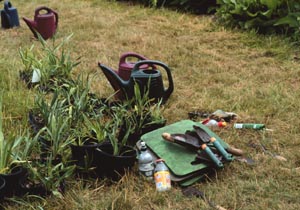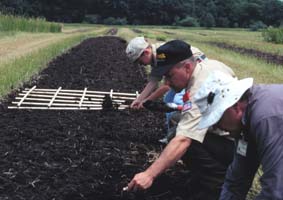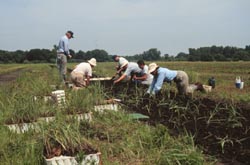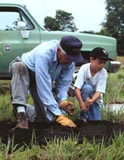
Although the sun has been up for hours, its still early on a Saturday for humans. Volunteers arrive in waves. Some are young and clutching large mugs of coffee, others are awake and eager to begin. Everyone comes dressed in clothes that are ready to get dirty. Some jeans even have a soft dirt-like appearance perfectly broken in work pants. People come with broad brimmed hats, and baseball caps to protect their skin from the intense morning sun. Sunscreen coats every exposed part of skin. Ears, noses, faces, necks, shoulders, arms, and hands are all protected. In addition to sunscreen and hats, everyone clasps water bottles for the hot day.

Time for Planting
After everything is unloaded from the truck and almost everyone has arrived, it is time to begin. The botanist who works for the restoration project gives instructions for the day. Planting will go on all day with a break for lunch. About six to eight people should work down a row together. That way people can switch duties to keep everything moving.
Everyone grabs a trowel, kneeling pad, and gloves and places them at the beginning of the row. Then the flats are retrieved from the shade, watering cans are filled up and the grid set. The plants must be planted at least 8 inches apart and in straight lines. A meter square grid was constructed to help make the planting go more quickly.

Two people take charge of moving and repositioning the grid. Another two grab trowels and dig a nice deep hole in each of the grid squares. A few others are settled on the ground taking the little plants out of the flats and the individual growing containers. After they take the plants out, they snip off the end of the roots. This will help the plant absorb water to re-establish itself in the ground. They work so fast that a pile of plants accumulates around them. After the holes have been dug, the plants get put in, and get a good soaking of water. Then the plants are covered with rich soil and the crew moves onto the next grid.
The water carriers cart the heavy watering cans back to the field. There is a long hose with a leaky nozzle on it from the huge water tank. A huge barrel catches the leaks from the hose and any generous fillings. When the water in the barrel is about to spill over, the watering cans can be filled from there too.
As the planting gets further down the row, there is always a watering can that is empty. The walk with two brimming cans gets longer and longer. When its your turn to fetch water, you finally realize how much planting the group has accomplished.

In one morning, one of the crews finishes planting a long row with hundreds and hundreds of plants. They'll grow tall in the hot summer sun and be ready for seed harvesting in the fall.

|
|
Copyright © 2000 Illinois State Museum